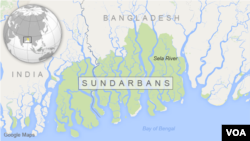Plans for a coal-fired power plant near the Sundarbans region in Bangladesh is being fiercely resisted by several environmental groups who say the plant poses serious threats to the world's largest mangrove forest.
The government of Bangladesh insists that the 1,320 megawatt power plant, once it is built in Rampal, off the northern edge of the Sundarbans, would cause no harm to the forest, which is recognized by the UNESCO as a World Natural Heritage Site.
Prime Minister Sheikh Hasina, in a nationally televised media conference Saturday, blamed the opposition Bangladesh Nationalist Party (BNP) and some associated groups, accusing them of conducting a “politically motivated propaganda” campaign against the government.
Bangladesh and India signed a deal in 2010 to jointly set up the $1.7 billion plant in Rampal.
Following last month’s signing of an agreement to begin the construction of the main plant, environmental activists, students, opposition BNP party workers and others have staged protests across the country demanding the plant be scrapped.
However, the government said in a statement last week that the ground work is going ahead as scheduled and the plant would begin operation by 2018.
International standards
“A section opposed to development in the country has for some time been indulging in a negative campaign against the Rampal plant and creating fear among people by providing false information about the power plant and related issues. As per international standards, a coal-fired plant should not be located within a 10 kilometer range of a forest,” Hasina said. “This plant in Rampal is located 14 kilometers away from the edge of the Sundarbans and 65 kilometers away from the World Natural Heritage zone.”
Citing data and statistics, the prime minister emphatically said the plant would in no way harm the Sundarbans.
But environmental experts and activists say they are not convinced by government claims.
AKM Wahiduzzaman, head of the Geography & Environment department of the National University of Bangladesh and a secretary for climate change issues for the BNP, said the prime minister’s arguments were “hollow.”
Noting that in neighboring India, the building of any coal-fired plant is not allowed within 25 kilometers of a forest, Professor Wahiduzzaman said, the Rampal plant - which , according to him, is 11 to 13 kilometers from the edge of the Sundarbans - is going to be built at a location "very unsafe" for the Sundarbans forest.
Problems with coal
One major issue cited by opponents of the plant is the importation of coal, which will arrive on large vessels before being transferred to boats at Akram Point, in the middle of the Heritage zone.
Wahiduzzaman said coal waste discharged at the point will contaminate the “most sensitive” core area of the forest.
“Discharge of coal, dirt, fuel and other chemicals from the frequently sailing large and small ships will heavily contaminate the adjacent rivers, sea and coast. There will also be sound and light pollutions, caused by the ships, which would hamper the ecosystem and the wildlife of the Sundarbans,” Wahiduzzaman said.
Kallol Mustafa, an engineer and an anti-pollution activist, said a coal-fired plant, however technologically advanced it is, poses a threat to an ecologically sensitive forest if it is not located at a safer distance.
He added that in Bangladesh “countless” industries flout safety measure norms, triggering rampant pollution.
“If the industrial units around Dhaka followed the pollution control norms properly, we would have not seen as much as 90,000 cubic meters of untreated liquid waste being dumped daily in the rivers around the capital,” he said. “In such a situation we cannot hope the Rampal plant will follow the pollution control norms perfectly, being located far away from Dhaka, close to the Sundarbans.”
Lack of power
The World Bank says as much as 40 percent of Bangladesh’s population has no access to electricity and businesses are being affected by power shortages.
The country has the capacity to generate about 14,000 megawatts of electricity, far short of current needs. And according to an estimate by the Bangladesh Power Development Board (BPDB), the national demand for power will top 35,000 megawatts by 2030. To deal with the problem, the government has plans to set up 25 coal-fired plants that would generate an additional 15,000 megawatts by the end of the next decade.
Sundarbans National Park (SNP) is known as a rich habitat for birds and many other endangered species, including the Bengal tiger and Ganges and Irrawaddy river dolphins.
A huge population of Bangladeshis are also directly dependent on the forest and its rivers for their livelihood. The mangrove forest also acts as a crucial buffer guarding Bangladesh from cyclones that routinely hit this region.








